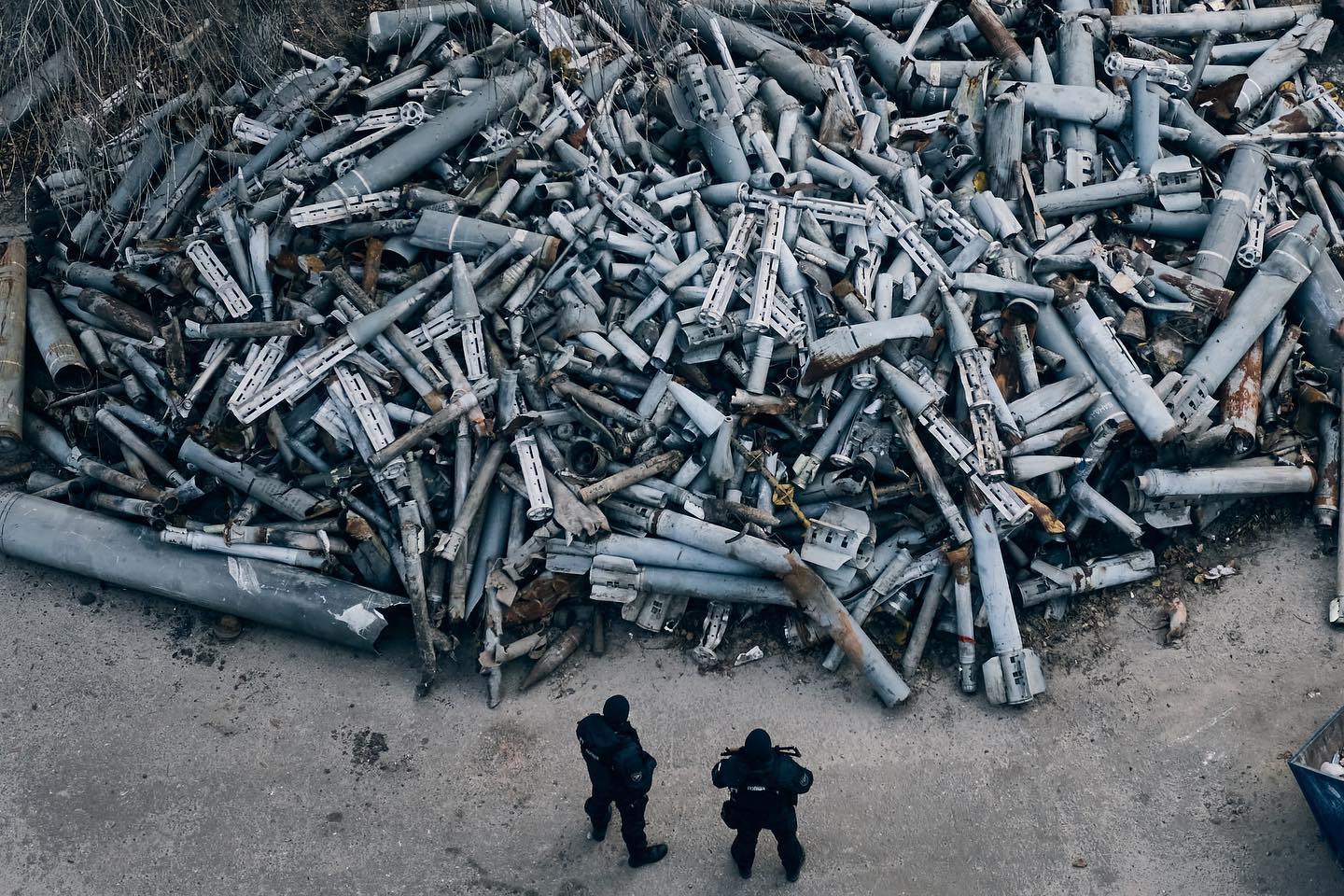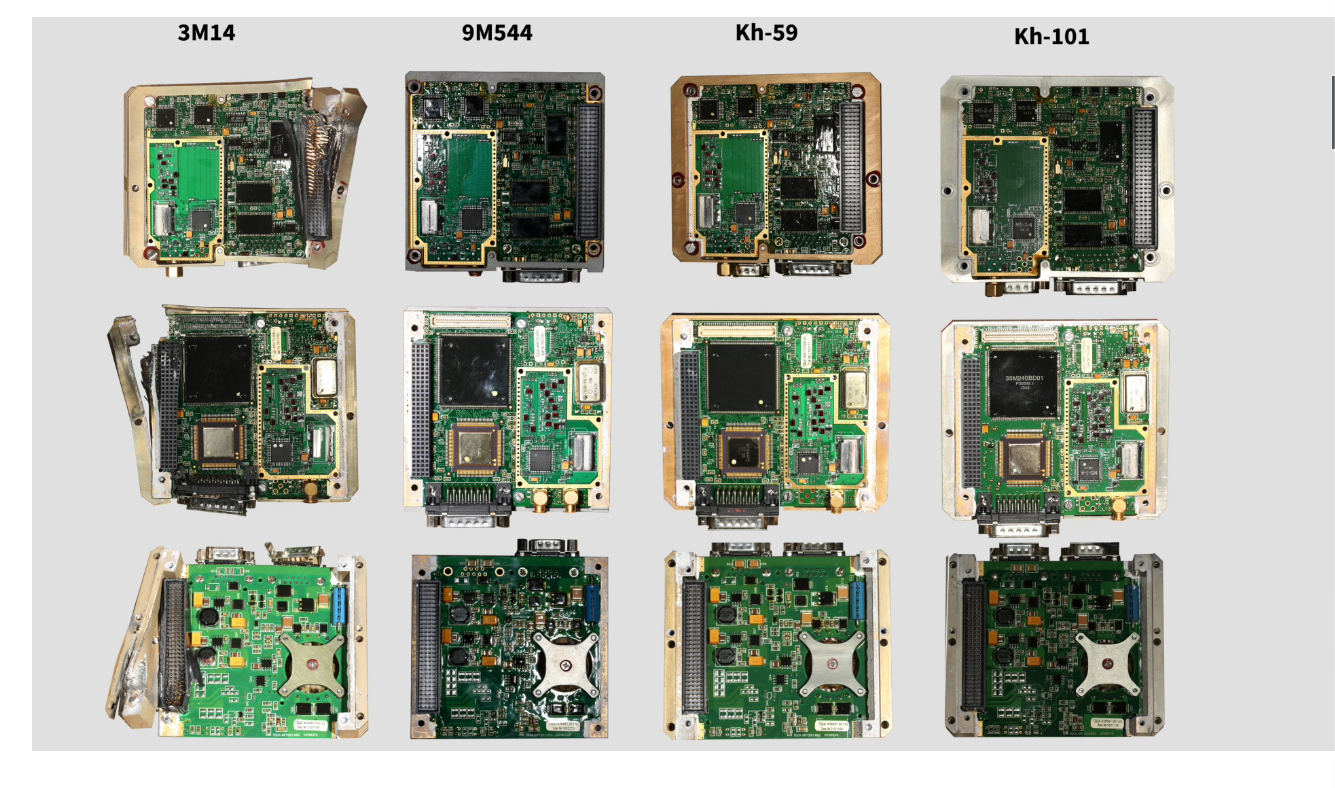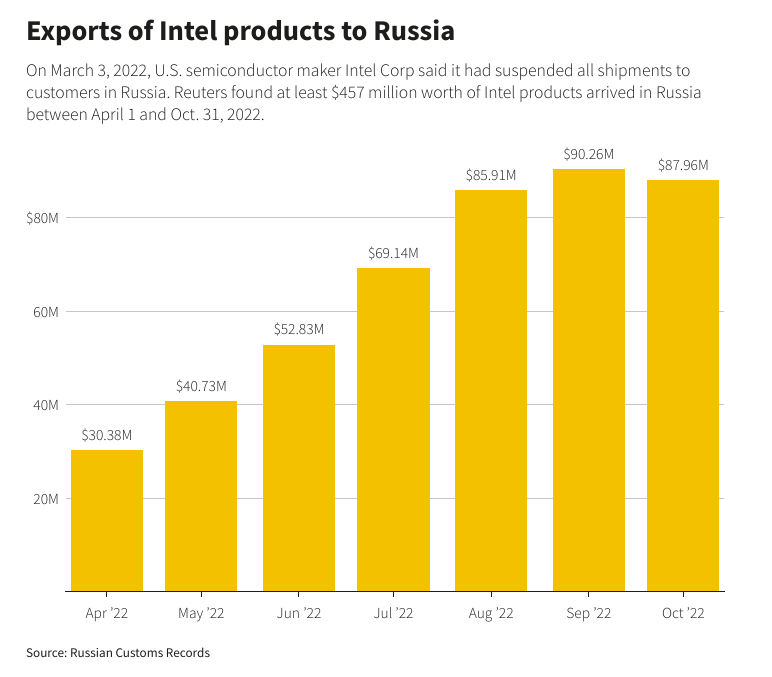"Western electronics in the heart of the Russian military machine"
A report with this title – Western Electronics at the Heart of Russia's War Machine – was released in August 2022 by the British Royal United Services Institute for Defense and Security Studies (RUSI). In it, the Institute's experts analyzed the technical performance and design of 27 types of the most modern Russian weapons, military and special equipment (AMSE) used since February 2022 in the war with Ukraine – cruise missiles, unmanned aerial vehicles (UAVs), communications and electronic warfare systems (EW), tanks.
Among the considered samples of military and military equipment are the Kh-59MK aviation guided missile, the Kh-101 cruise missile, the 9M727 (R-500) cruise missile and the 9M723 tactical missile for the Iskander complexes, the 9M549 guided missile for the Tornado-S MLRS, the UAV " Orlan-10”, T-72B3M tank, Akveduk digital radio communication complex, Azart digital radio station, Borisoglebsk-2 electronic warfare complex. Some of them fell into the hands of the Ukrainian military intact, in other cases we are talking about fragments or separate units or blocks of damaged and disabled pieces of equipment or missiles fired at Ukraine.

RUSI experts identified a total of 450 microelectronic products manufactured by companies in the US, Europe and East Asia. The vast majority of them – 317 – are of American origin. Next come companies from Japan (34), Taiwan (30) and Switzerland (14). Some of them were released back in the late 1980s, others date back to 2018 and 2019, that is, the period after US and EU sanctions were imposed on Russia in 2014 regarding the export of sensitive technologies.
Most of the Western electronics found inside Russian weapons came from US companies such as Analog Devices Inc., Texas Instruments, Intel, Atmel Corporation. For example, the Russian 9M727 and Kh-101 cruise missiles contained three dozen foreign chips each, including in key system components like on-board computers and guidance modules. In the most successful Russian serial drone, Orlan-10, RUSI researchers found foreign pressure sensors, navigation modules, microcontrollers and other equipment.
Most of the Western electronics found in Russian weapons came from US companies.
Experts from the British non-profit organization Conflict Armament Research (CAR) published a similar report in September 2022 on the electronics of Russian weapons used in the fighting in Ukraine – Ka-52 helicopters, cruise missiles, UAVs and communications equipment . They were able to identify and describe 650 samples of microelectronic products from 144 non-Russian manufacturers. Many titles were released after 2014, when sanctions were already in place against Russia, some in 2021.
According to CAR, the Russian defense industry works with typical sets of microelectronic components for various weapons systems (control and navigation units, on-board digital computers, antennas), relying on a limited set of foreign-origin technologies and, obviously, not expecting supply chains to abroad may be violated. The organization's Damien Spleeters told The New York Times, "Russia's advanced weapons and communications systems are built on Western chips," adding that Russian companies have enjoyed "unrestricted access" to Western technology for decades.
Advanced Russian weapons and communications systems built on Western chips
The American NGO Robert Lansing Institute (RLI) in its review of the supply of military equipment and equipment from NATO countries to Russia, published in June 2022, emphasizes the breadth and diversity of the range of Western element base present in the products of the domestic military-industrial complex – not only in rockets and aircraft, but also in individual equipment like binoculars, rangefinders, thermal imagers and equipment of the "soldier of the future" "Warrior".
The conclusions of RUSI, CAR and RLI about the dependence of Russian weapons and equipment on Western electronics are consistent with the information of the Ukrainian military and volunteers, who periodically publish or transmit to journalists data on the configuration of captured Russian military equipment. In particular, foreign chips were found in the communications equipment of the command and control vehicle of the Barnaul-T air defense target reconnaissance complex, the direction finder of the Pantsir anti-aircraft missile and gun system, the automatic guidance system of the Su-24M front-line bomber, and the fire control system of the BMD- airborne combat vehicle. 4 , reconnaissance UAV "Cartographer" and many other samples. According to the Ukrainian initiative Trap Aggressor, a total of 39 types of Russian military equipment with 170 items of microelectronics or finished units of foreign origin from manufacturers from 69 countries have been reliably identified.
When electronics kill
During the nine months of the war, Russia launched more than 16,000 missile and artillery strikes on Ukraine. The most serious threat comes from high-precision missiles. According to the calculations of the Ministry of Defense of Ukraine, from February 23, 2022 to January 3, 2023, Russian troops fired almost 4.5 thousand missiles, including:
- 1328 anti-aircraft guided missiles for S-300 systems (they are used against ground targets near the line of contact);
- 744 tactical missiles 9M723;
- 638 air missiles Kh-29, Kh-31, Kh-35, Kh-58, Kh-59;
- 616 Kh-101, Kh-555, Kh-55SM strategic cruise missiles;
- 591 Caliber sea-launched cruise missiles;
- 208 Kh-22/32 aircraft missiles;
- 144 Onyx anti-ship missiles;
- 68 cruise missiles 9M728/9M729;
- 10 hypersonic missiles "Dagger".
A significant part of the listed means of long-range fire destruction works only thanks to foreign microcircuits in on-board systems responsible for flight control and regular guidance to a given target. Therefore, since the introduction of unprecedented restrictions on the export of electronics in the spring of 2022, officials and experts in Ukraine, the United States and the EU have repeatedly voiced forecasts of the imminent depletion of stocks of precision-guided missiles due to problems with access to the components necessary for their production.

In fact, as early as 2014, the export of electronics to Russia came under the tight control of the US Bureau of Industry and Security (BIS), the government agency responsible for issuing licenses for the export and re-export of high-tech military and dual-use products. Following the Americans, similar restrictions were soon introduced in the European Union.
All this time, the set of measures and procedures applied by the BIS and EU authorities has expanded and tightened, as well as the list of sanctioned companies and organizations. Since February 2022, the regime of restrictions has acquired the features of a full-fledged embargo. However, RUSI estimates that out of 450 microelectronic items found in Russian weapons, 81 components are classified as dual-use items in the US, requiring a separate license.
Reuters quoted an unnamed Ukrainian official as succinctly explaining the problem: "Without these American chips, Russian missiles and most Russian weapons would not be able to work."
Without American chips, Russian missiles and most Russian weapons would not be able to work.
The products of the Western radio-electronic industry most in demand by the Russian military-industrial complex are microprocessors, microcontrollers, programmable logic integrated circuits (Complex Programmable Logic Device, CPLD) and user-programmable gate arrays (Field-Programmable Gate Array, FPGA) – these are devices that allow you to customize the operation of integrated circuits for specific tasks.
Electronic components of sensors, navigation systems, cryptographic and optical equipment are also widely used. Even such seemingly low-tech weapons of war as armored fighting vehicles are heavily dependent on Western chips. During the tragic events near Kiev, when civilians tried to leave Bucha in cars, the Russian BMD-4M shot them with incredible accuracy due to the sighting system , equipped with a thermal imager and a rangefinder from the French company Thales.

As for the effect of sanctions, last summer there was indeed a lull in rocket attacks, but since October 10, 2022, the Kremlin began a campaign of targeted destruction of Ukrainian energy infrastructure with the help of those very high-precision missiles, hoping to deprive Ukrainians of electricity and heating during the winter cold and force authorities in Kiev to negotiations on Russian terms. After another massive raid, the Ministry of Defense of the Russian Federation, as if in a mockery of those who hoped for the effectiveness of the sanctions, posted on the Telegram channel an expressive picture “Calibers will never run out!”.
The first massive rocket attack on Ukraine in 2023 with Kh-22, Kh-101, Kh-555, Kalibr cruise missiles and Kh-59 guided air missiles led to a tragedy in the city of Dnipro, where, according to Ukrainian officials, the Kh- 22, launched by a Tu-22M3 long-range bomber from the airspace of the Kursk region, hit a residential building. As a result, 45 people died , including six children, 79 were injured. The next morning, a no less cynical picture appeared on the Telegram channel of the Ministry of Defense of the Russian Federation “We are charging to the fullest”.
How the Kremlin is getting out of the situation
The aforementioned RUSI report suggests that all the Kremlin’s efforts since 2014 to import-substitute technologies critical for defense construction have failed. It was not possible to either develop their own analogues or replace Western electronics with similar ones from neutral and friendly countries. At first glance, this is true.
Despite all the efforts to develop the radio-electronic industry within the framework of federal targeted programs (not even from 2014, but from 2008), on the eve of the invasion of Ukraine, the state of the elemental component base for the WMSE radio-electronic equipment did not reach the world level in any of the main categories. In 2022, at the height of the war, in January-September the government financed the state program “Development of the Electronic and Radio-Electronic Industry” by only 13.9%.

Reuters, citing internal documents from one of the Russian research institutes, reported that in 2017, when analyzing a promising helicopter electronic jamming complex, it turned out that for 921 foreign components needed to start production, there are only 242 domestic counterparts . Even in the strategic intercontinental ballistic missile "Sarmat", which Vladimir Putin and smaller figures are trying to scare the West, probably, there was a foreign element base.
Bloomberg provided interesting data on the progress of import substitution in the defense sector, citing a classified government report. The document states that the import substitution program for the period up to 2025, covering 177,058 parts, units and assemblies in 258 types of military equipment, has failed miserably. In 2020, it was possible to find a replacement for a total of 3,148 components (out of 18,047 planned for this year) in five models of equipment (out of 43 planned).
In September 2022, the Politico publication published an equally curious document – a list of needs for foreign microelectronics compiled somewhere in the depths of the Russian bureaucratic machine, divided into three levels of priority. In the urgent need category, there are 25 US, Japanese and German-made chips, and some of them disappeared from the market not because of sanctions, but because of the global shortage of semiconductors.
Be that as it may, rocket attacks on the territory of Ukraine do not stop. The latest waves of massive attacks are using cruise missiles launched just a few months ago. This can be interpreted as confirmation of reports about the depletion of missile weapons. And it can be exactly the opposite: as evidence of the successful work of the domestic military-industrial complex, which retains the ability to produce technologically complex products in spite of all sanctions and export control regimes.
Apparently, Russian importers successfully circumvent all restrictions through various schemes and tricks: intermediaries, the use of consumer electronics in military products, the replacement of foreign microcircuits with a hopelessly outdated but workable Soviet element base, a deliberate rejection of more advanced foreign models in favor of less advanced ones, industrial espionage, re-export through third countries.
Russian electronics importers successfully circumvent all restrictions through various schemes and tricks
Experts note that many foreign chips found in Russian weapons are standard elements of general-purpose electronic systems. Often the same integrated circuits are used in household appliances, gadgets, and weapons. In May 2022, US Secretary of Commerce Gina Raimondo spoke with reference to Ukrainian officials about semiconductors found in Russian tanks from dishwashers and refrigerators.
Ukrainian experts say that Russian manufacturers have found a way to integrate household chips even into such complex devices as the on-board computer systems of high-precision missiles. For example, experts found microcircuits and microcontrollers available for ordering on the Chinese online trading platform AliExpress in the 9M544 guided missile guidance unit for the Tornado-S MLRS.

Paradoxically, modern Russian weapons such as the Kh-101 cruise missiles contain , along with Western components, Soviet microcircuits from the 1960s and 1970s. It seems that this is one way to reduce dependence on foreign electronics (some experts believe that the X-101 can be produced without it at all), but in this case, one has to put up with a significant decrease in accuracy and reliability.
Another explanation for the continued production of sophisticated military products despite the sanctions is stocks of electronics made before the start of the war. The well-known defense analyst Janes wrote a report for The New York Times about a likely deliberate policy of hoarding critical components in the post-2014 period. Since some of them belong to civilian products, deliveries could be organized completely legally or with the help of third countries. In addition, Russian defense enterprises apparently obtained some share of electronic components through the intelligence network of the SVR and the GRU.
Finally, the most important source of electronics for the domestic military-industrial complex is ordinary imports. The Federal Customs Service of the Russian Federation stopped publishing detailed statistics on imports and exports in April 2022, in part to make it difficult to assess the effectiveness of sanctions imposed by the West on the supply of high-tech goods and electronic components. Nevertheless, Reuters managed to get access to Russian customs records from February 24 to the end of May and found out that during this time more than 15,000 transactions occurred with the import of Western electronics to Russia from AMD, Analog Devices, Infineon, Intel, Texas Instruments and others. manufacturers.
The main source of electronics for the domestic military-industrial complex is ordinary imports
A more complete picture was later presented by the well-known economist Maxim Mironov, who published summary data from the FCS database for the nine months of 2022. According to Mironov, imports of semiconductors in two main categories “diodes, transistors and similar semiconductor devices” (TN VED heading 8541) and “electronic integrated circuits” (8542) after a sharp drop in March 2022, not only quickly recovered to average monthly values the previous year, but surpassed them. In September 2022, semiconductors worth $277 million were imported into Russia, which is more than one and a half times higher than in September 2021 ($173 million). At the same time, supplier countries have changed in a characteristic way: the volume of imports from the EU and the USA has sharply decreased (although not completely disappeared), the share of China has reached 80%, semiconductors suddenly began to come from Turkey and the CIS countries.
Совместное расследование Reuters и RUSI, выпущенное в декабре 2022 года, говорит о прекрасно работающей, несмотря на все санкции, глобальной сети поставщиков западной электроники в Россию. Операции идут через посредников в Турции, Гонконге и даже Эстонии (член ЕС и НАТО) и, вероятно, закрывают основные нужды российских потребителей. Со ссылкой на полученные данные ФТС агентство пишет об удивительной ситуации с американском гигантом Intel: компания 3 марта 2022 года объявила об остановке работы с российскими клиентами. Тем не менее с 1 апреля по 31 октября 2022 года в Россию каким-то образом завезли продукции Intel на $457 млн. Всего за этот период в страну поступило компонентов компьютерной техники и электроники на сумму $2,6 млрд, из них $777 млн приходится на американские Intel, AMD, Texas Instruments, Analog Devices Inc. и немецкую Infineon AG.

То, что режим западных санкций не работает так, как надо, показывает не только российское оружие. Организация CAR проанализировала попавшие в руки украинцев дроны-камикадзе «Герань-1» и «Герань-2». Эксперты не только подтвердили, что эти дроны (под оригинальными названиями Shahed 131 и Shahed 136) разработаны в Иране, а не в России, но и выявили огромное количество западной электроники. По сути, все основные узлы и системы дронов сделаны на базе иностранных компонентов, причем больше всего из них имеют американское происхождение. Украинский проект «Схемы» изучил другой иранский БЛА, применяемый российскими силами в Украине, — разведывательно-ударный Mohajer-6, и в нем точно также нашли микросхемы от производителей из США.
Если находящийся под санкциями разной степени жесткости уже много десятилетий Иран ухитряется на регулярной основе получать западную электронику для производства оружия, то что говорить о России, до сих пор гораздо глубже включенной в мировой рынок, не испытывающей (пока) проблем с финансами и располагающей неформальными сетями влияния на политиков и бизнес за рубежом. Похоже, что в современном мире попытка отрезать любую крупную страну от микроэлектронной продукции — в принципе нерешаемая задача. И до тех пор, пока в Украине продолжается война, американские и европейские чипы продолжат помогать убивать украинцев.
Несамодостаточная российская электроника
Иен Уильямс, научный сотрудник Центра стратегических и международных исследований (CША)
Новые российские ракеты, похоже, содержат много компонентов западного производства. Многие из них находятся в свободном доступе на рынке, поскольку у них невоенное применение — например, в сфере гражданской электроники и бытовой техники. Однако очевидна низкая надежность этих новых ракет. Это может быть связано с плохой системной интеграцией и плохим контролем качества конечного продукта. Есть и подтвержденные случаи присутствия компонентов двойного назначения в российском оружии. Это не обязательно плохо — дело не только в качестве комплектующих, но и в интеграции этих деталей с элементами российского производства, качестве сборки, мерах контроля качества и т. д. Что касается дефицита электронных компонентов, я думаю, что Китай был бы единственным значительным источником для России. Иран, вероятно, готов продавать только целые системы, такие как Shahed 136. Однако эта страна сама зависит от иностранной электроники.
У России сейчас нет промышленных мощностей для производства высокотехнологичного оружия, такого как крылатые ракеты, такими темпами, как это необходимо. Ужесточение импортных ограничений заставит Кремль искать электронные компоненты в других местах. Даже если Россия сможет получить новые источники микросхем, могут возникнуть проблемы с интеграцией и несоответствие между деталями и исходным дизайном, что, вероятно, приведет к снижению качества и надежности. Вся эта ситуация довольно неожиданна, поскольку до сих пор считалось, что российская радиоэлектронная промышленность развилась непосредственно из советской радиоэлектронной промышленности, которая была вполне самодостаточной.
Материал подготовлен совместно с Вячеславом Епуряну


